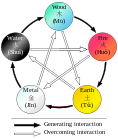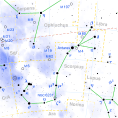Definify.com
Definition 2025
火
火
Translingual
| Stroke order | |||
|---|---|---|---|

| |||
Alternative forms
- 灬 (when used as a bottom Chinese radical)
Han character
火 (radical 86 火+0, 4 strokes, cangjie input 火 (F), four-corner 90800)
- Kangxi radical #86, ⽕ (“fire”).
Derived characters
References
- KangXi: page 665, character 1
- Dai Kanwa Jiten: character 18850
- Dae Jaweon: page 1073, character 19
- Hanyu Da Zidian: volume 3, page 2187, character 1
- Unihan data for U+706B
Chinese
|
simp. and trad. |
火 | |
|---|---|---|
Glyph origin
| Historical forms of the character 火
| ||||
|---|---|---|---|---|
| Oracle bone script | Bronze inscriptions | Bamboo and silk script | Large seal script | Small seal script |
 |
 |
 |
 |
 |
| Characters in the same phonetic series (火) (Zhengzhang, 2003) | |
|---|---|
| Old Chinese | |
| 火 | *qʰʷaːlʔ |
| 邩 | *qʰʷaːlʔ |
| 伙 | *qʰʷaːlʔ |
Pictogram (象形) – pictographic representation of a fire.
Etymology
Possibly from Proto-Sino-Tibetan *mej.
Pronunciation
- Mandarin
- Cantonese (Jyutping): fo2
- Hakka (Sixian, PFS): fó
- Min Dong (BUC): huōi / huō
- Min Nan (POJ): hóe / hé / hér
- Wu (Wiktionary): hu (T2)
- Mandarin
- (Standard Chinese, Beijing)+
- Pinyin:
- Zhuyin: ㄏㄨㄛˇ
- Wade-Giles: ho3
- Gwoyeu Romatzyh: huoo
- IPA (key): /xu̯ɔ²¹⁴/
- (Standard Chinese, Beijing)+
- Cantonese
- (Standard Cantonese, Guangzhou)+
- Jyutping: fo2
- Yale: fó
- Cantonese Pinyin: fo2
- IPA (key): /fɔː³⁵/
- (Standard Cantonese, Guangzhou)+
- Hakka
- (Sixian, incl. Miaoli and Meinong)
- Pha̍k-fa-sṳ: fó
- Hakka Romanization System: fo`
- Hagfa Pinyim: fo3
- IPA: /fo³¹/
- (Sixian, incl. Miaoli and Meinong)
- Min Dong
- (Fuzhou)
- Bàng-uâ-cê: huōi / huō
- IPA (key): /hui³³/, /huo³³/
- Note: huōi - colloquial; huō - literary.
- (Fuzhou)
- Min Nan
- (Hokkien: Zhangzhou, Kaohsiung, Tainan, Yilan, Taichung)
- Pe̍h-ōe-jī: hóe
- Tâi-lô: hué
- Phofsit Daibuun: hoea
- IPA (Zhangzhou): /hue⁵³/
- IPA (Kaohsiung): /hue⁴¹/
- (Hokkien: Taipei, Magong, Hsinchu)
- Pe̍h-ōe-jī: hé
- Tâi-lô: hé
- Phofsit Daibuun: hea
- IPA (Taipei): /he⁵³/
- (Hokkien: Quanzhou, Lukang, Sanxia, Kinmen, Hsinchu)
- Pe̍h-ōe-jī: hér
- Tâi-lô: hér
- IPA (Quanzhou): /hə⁵⁵⁴/
- (Hokkien: Zhangzhou, Kaohsiung, Tainan, Yilan, Taichung)
- Wu
- (Shanghainese)
- Wiktionary: hu (T2)
- IPA (key): /hv̩ʷ³⁴/
- (Shanghainese)
| Rime | |
|---|---|
| Character | 火 |
| Reading # | 1/1 |
| Initial (聲) | 曉 (32) |
| Final (韻) | 戈 (95) |
| Tone (調) | Rising (X) |
| Openness (開合) | Closed |
| Division (等) | I |
| Fanqie | 呼果切 |
| Reconstructions | |
| Zhengzhang Shangfang |
/huɑX/ |
| Pan Wuyun |
/huɑX/ |
| Shao Rongfen |
/xuɑX/ |
| Edwin Pulleyblank |
/hwaX/ |
| Li Rong |
/xuɑX/ |
| Wang Li |
/xuɑX/ |
| Bernard Karlgren |
/xuɑX/ |
| Expected Mandarin Reflex |
huǒ |
| Baxter-Sagart system 1.1 (2014) | |
|---|---|
| Character | 火 |
| Reading # | 1/1 |
| Modern Beijing (Pinyin) |
huǒ |
| Middle Chinese |
‹ xwaX › |
| Old Chinese |
/*[qʷʰ]ˤəjʔ/ |
| English | fire |
Notes for Old Chinese notations in the Baxter-Sagart system: * Parentheses "()" indicate uncertain presence; | |
| Zhengzhang system (2003) | |
|---|---|
| Character | 火 |
| Reading # | 1/1 |
| No. | 5540 |
| Phonetic component |
火 |
| Rime group |
歌 |
| Rime subdivision |
1 |
| Corresponding MC rime |
火 |
| Old Chinese |
/*qʰʷaːlʔ/ |
Definitions
火
- fire; flame
- fire (as a disaster); inferno
- red; fiery; bright; brilliant
- to burn down
- light; torch
- anger; rage; wrath
- to become enraged
- angry; furious
- (TCM) internal heat
- firearm; ammunition; weapon
- war; warfare
- thriving; brisk
- urgent; pressing
- (neologism) to become popular; to go viral
- Short for 火星 (Huǒxīng, “Mars”).
Compounds
|
|
|
Descendants
Japanese
Kanji
Readings
Compounds
|
|
Etymology 1
| Kanji in this term |
|---|
| 火 |
|
ひ Grade: 1 |
| kun'yomi |
From Old Japanese. /hi2/: [pɨ] > [ɸɨ] > [ɸi] > [çi].[1]
Possibly a later development from older form ho (see below).
Pronunciation
Noun
Derived terms
Idioms
|
Etymology 2
| Kanji in this term |
|---|
| 火 |
|
ほ Grade: 1 |
| kun'yomi |
From Old Japanese. /ho/: [po] > [ɸo] > [ho].[1]
Only used in compounds, whereas hi (see above) appears even in ancient texts as a standalone term. Probably the oldest form. Possibly cognate with Korean 불 (bul, “fire”).
Pronunciation
Noun
- a fire
Derived terms
Etymology 3
| Kanji in this term |
|---|
| 火 |
|
ふ Grade: 1 |
| kun'yomi |
From Old Japanese. Ancient dialect form in eastern Japan.[1] Found in compounds.
Pronunciation
Noun
- a fire
Derived terms
- 葦火 (ashifu): ancient eastern Japanese dialect reading for 葦火 (ashibi): a fire using dried reeds as kindling or fuel
Etymology 4
| Kanji in this term |
|---|
| 火 |
|
か Grade: 1 |
| on'yomi |
From Middle Chinese 火 (xwaX).[1]
Pronunciation
Noun
火 (hiragana か, romaji ka, historical hiragana くわ)
- fire
- one of the five classical elements in traditional Chinese philosophy and medicine: see the "Wu Xing" entry on Wikipedia
- under the old Ritsuryō system of ancient Japan, a military grouping, consisting of 10 soldiers: a squad
Idioms
- 火中の栗を拾う (kachū no kuri o hirō): “to pick chestnuts out of a fire” → to take a risk
Synonyms
- (squad): (modern Japanese) 分隊 (buntai)
Proper noun
火 (hiragana か, romaji Ka, historical hiragana くわ)
- Tuesday
- Antares, in the constellation Scorpio
Synonyms
References
- 1 2 3 4 1988, 国語大辞典(新装版) (Kokugo Dai Jiten, Revised Edition) (in Japanese), Tōkyō: Shogakukan
- 1 2 2006, 大辞林 (Daijirin), Third Edition (in Japanese), Tōkyō: Sanseidō, ISBN 4-385-13905-9

